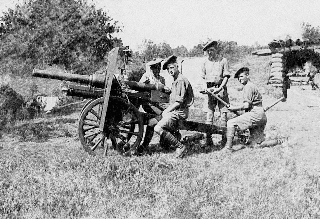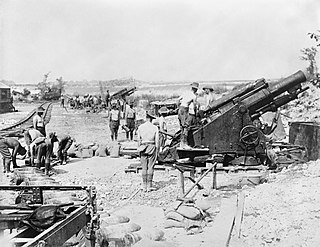
The Ordnance QF 18-pounder, or simply 18-pounder gun, was the standard British Empire field gun of the First World War-era. It formed the backbone of the Royal Field Artillery during the war, and was produced in large numbers. It was used by British Forces in all the main theatres, and by British troops in Russia in 1919. Its calibre (84 mm) and shell weight were greater than those of the equivalent field guns in French (75 mm) and German (77 mm) service. It was generally horse drawn until mechanisation in the 1930s.

The Ordnance BL 2.75-inch mountain gun was a screw gun designed for and used by the Indian Mountain Artillery into World War I.

The Ordnance BL 60-pounder was a British 5 inch (127 mm) heavy field gun designed in 1903–05 to provide a new capability that had been partially met by the interim QF 4.7 inch Gun. It was designed for both horse draft and mechanical traction and served throughout the First World War in the main theatres. It remained in service with British and Commonwealth forces in the inter-war period and in frontline service with British and South African batteries until 1942 being superseded by the BL 4.5 inch Medium Gun.

The BL 4.5 inch medium gun was a British gun used by field artillery in the Second World War for counter-battery fire. Developed as a replacement for the BL 60-pounder gun it used the same carriage as the BL 5.5-inch medium gun but fired a lighter round a further distance.

The BL 8-inch howitzer Marks VI, VII and VIII were a series of British artillery siege howitzers on mobile carriages of a new design introduced in World War I. They were designed by Vickers in Britain and produced by all four British artillery manufacturers, but mainly by Armstrong, and one American company. They were the equivalents of the German 21 cm Morser 16 and in British service were used similarly to the BL 9.2-inch howitzer, but were quicker to manufacture, and more mobile. They delivered a 200 lb (91 kg) shell to 12,300 yards (11.2 km). They had limited service in the British Army in World War II before being converted to the new 7.2-inch (180 mm) calibre. They also equipped a small number of Australian and Canadian batteries in World War I and by the US Army in that war. They were used in small numbers by other European armies.

The Ordnance BL 6 inch 26cwt howitzer was a British howitzer used during World War I and World War II. The qualifier "26cwt" refers to the weight of the barrel and breech together which weighed 26 long hundredweight (1.3 t).

The Ordnance BL 6 inch 30cwt howitzer was a British medium howitzer used in the Second Boer War and early in World War I. The qualifier "30cwt" refers to the weight of the barrel and breech together which weighed 30 hundredweight (cwt) : 30 × 112 lb = 3,360 lb. It can be identified by the slightly flared shape of the muzzle and large recuperator springs below the barrel.

The BL 6-inch gun Mark VII was a British naval gun dating from 1899, which was mounted on a heavy travelling carriage in 1915 for British Army service to become one of the main heavy field guns in the First World War, and also served as one of the main coast defence guns throughout the British Empire until the 1950s.

The Ordnance BL 9.2-inch howitzer was a heavy siege howitzer that formed the principal counter-battery equipment of British forces in France in World War I. It equipped a substantial number of siege batteries of the Royal Garrison Artillery. It remained in service until about the beginning of World War II.

The British Ordnance BL 12 inch howitzer on truck, railway, a type of railway gun, was developed following the success of the 9.2-inch siege howitzer. It was similar but unrelated to the 12-inch siege howitzers Mk II and IV.

The Ordnance BL 12-inch howitzer was a scaled-up version of the successful BL 9.2-inch siege howitzer.

The QF 3 inch 20 cwt anti-aircraft gun became the standard anti-aircraft gun used in the home defence of the United Kingdom against German airships and bombers and on the Western Front in World War I. It was also common on British warships in World War I and submarines in World War II. 20 cwt referred to the weight of the barrel and breech, to differentiate it from other 3 inch guns. While other AA guns also had a bore of 3 inches (76 mm), the term 3 inch was only ever used to identify this gun in the World War I era, and hence this is what writers are usually referring to by 3 inch AA gun.

The Ordnance BL 15-pounder, otherwise known as the 15-pounder 7 cwt, was the British Army's field gun in the Second Boer War and some remained in limited use in minor theatres of World War I. It fired a shell of 3-inch diameter with a maximum weight of 15 pounds (6.8 kg), hence its name which differentiated it from its predecessor '12-pounder' 3-inch gun which fired shells weighing only 12.5 pounds (5.7 kg).

The Ordnance BL 12-pounder 6 cwt was a lighter version of the British 12-pounder 7 cwt gun, used by the Royal Horse Artillery in the late 19th and early 20th centuries.

The QF 6-inch 40 calibre naval gun (Quick-Firing) was used by many United Kingdom-built warships around the end of the 19th century and the start of the 20th century.

The BL 12 inch naval gun Mk I was a British rifled breech-loading naval gun of the early 1880s intended for the largest warships such as battleships and also coastal defence. It was Britain's first attempt to match the large guns being installed in rival European navies, particularly France, after Britain transitioned from rifled muzzle-loading guns to the modern rifled breech-loaders somewhat later than the European powers. Mks I - VII all had a barrel of approximately 303 inches in length and similar performance.

The BL 9.2-inch Mk I–VII guns were a family of early British heavy breechloading naval and coast defence guns in service from 1881 to the end of World War I. They were originally designed to use the old gunpowder propellants.

The BL 6-inch gun Marks II, III, IV and VI were the second and subsequent generations of British 6-inch rifled breechloading naval guns, designed by the Royal Gun Factory in the 1880s following the first 6-inch breechloader, the relatively unsuccessful BL 6-inch 80-pounder gun designed by Elswick Ordnance. They were originally designed to use the old gunpowder propellants but from the mid-1890s onwards were adapted to use the new cordite propellant. They were superseded on new warships by the QF 6-inch gun from 1891.

The BL 10 inch guns Mks I, II, III, IV were British rifled breechloading 32-calibre naval and coast defence guns in service from 1885.

The BL 4-inch gun Mk I – Mk VI were a family of early British breech-loading 4-inch naval guns.






















